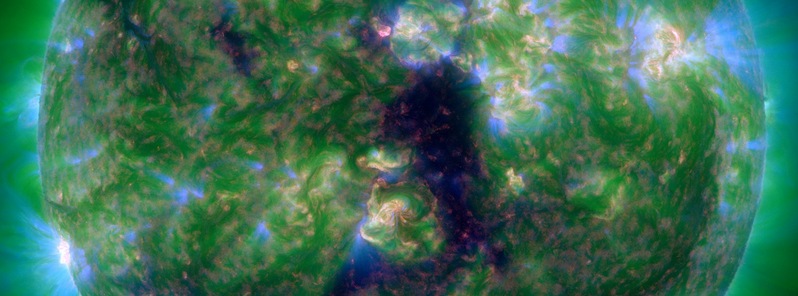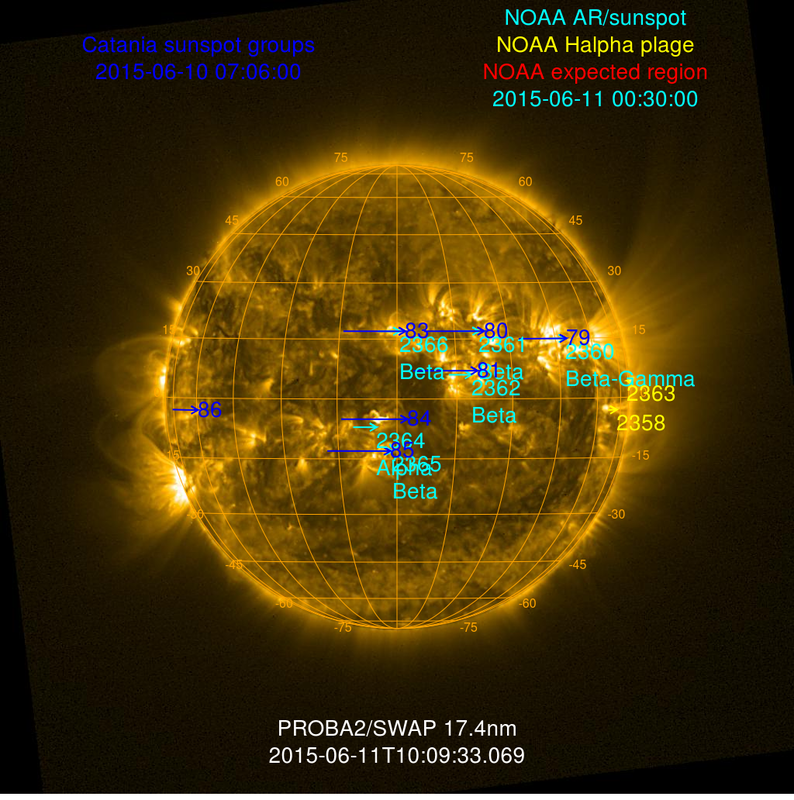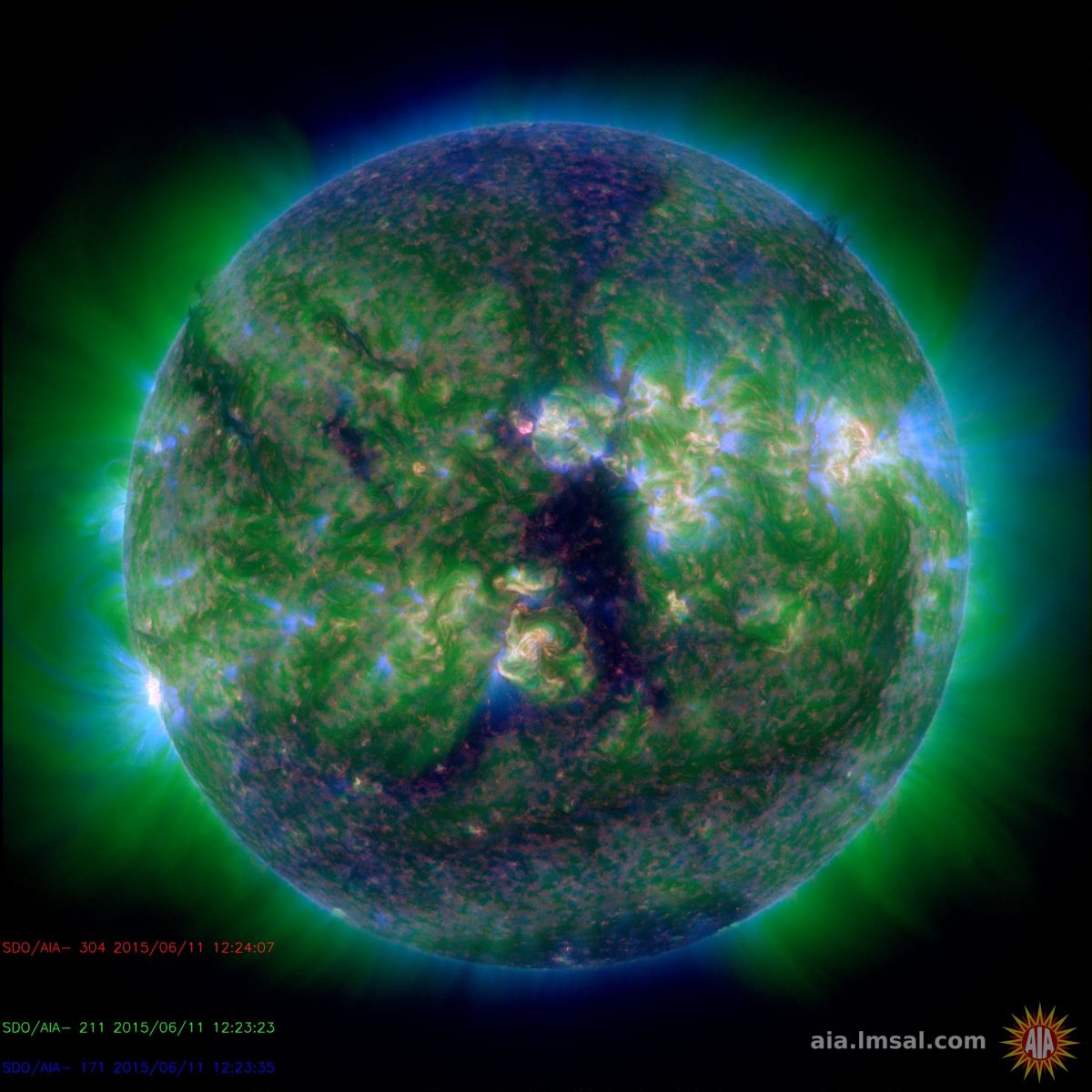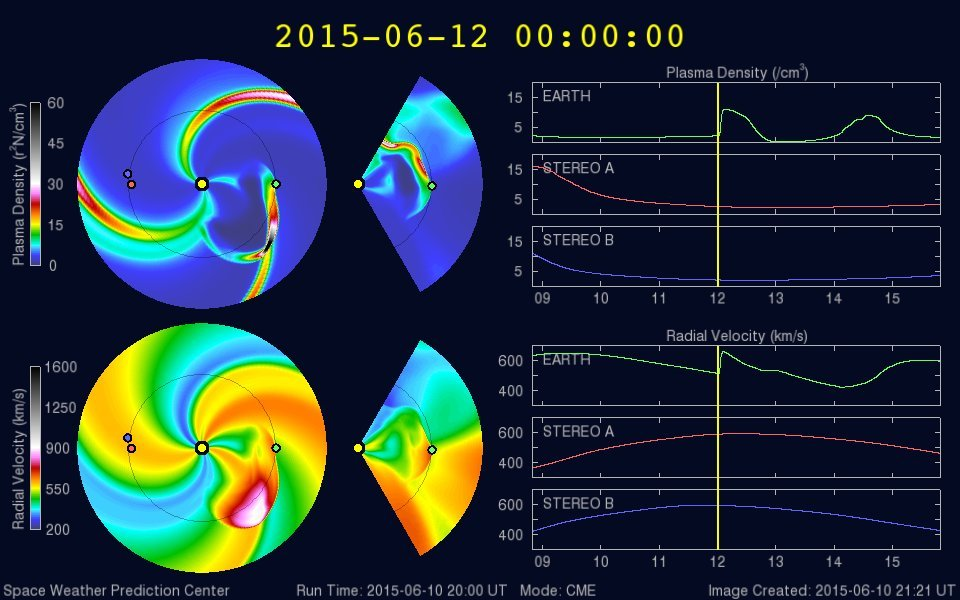Increased solar activity, glancing blow CME impact expected on June 12

Solar activity has increased to moderate levels during last 24 hours with an impulsive M1.0 solar flare (R1-Minor) at 08:55 UTC on June 11, 2015. The source was an area of enhanced emission on the Sun's east limb.
Current SDO imagery reveals a cluster of sunspots rotating onto the SE limb in the vicinity of the M1 flare, SWPC noted in their Forecast Discussion published 12:30 UTC on June 11, 2015.
Numerous low to mid-level C-class activity occurred in last 24 hours, primarily from Region 2360 (N14W48, Cai/beta-gamma), the agency said. The largest C-class activity was a C4/Sf from Region 2360 observed at 02:43 UTC. The region continued its slow decline exhibiting leader and intermediate spot decay.

Sunspots on June 11, 2015. Image credit: ESA/PROBA2/SWAP.
Region 2365 (S12E01, Cao/beta) indicated some consolidation in the leader portion with slight intermediate spot growth. Region 2366 (N17W02, Dao/beta) had mature penumbra growth with some leader spot decay.
The remainder of the spotted regions were either stable or in decay.
SWPC's forecasters expect solar activity to be low with a chance for M-class activity over the next three days (June 11 – 13, 2015) primarily from areas of enhanced emission on the east limb.

SDO AIA 304, 211, 171 on June 11, 2015 at 12:23 UTC. Image credit: NASA/SDO/LMSAL.
The greater than 2 MeV electron flux reached high levels in last 24 hours with a peak flux of 4603 pfu at 17:35 UTC on June 10. It is expected to remain at moderate to high levels from June 11 – 13 in response to coronal hole high speed stream (CH HSS) effects.
Solar wind speeds remained in the mid 500 km/s to lower 600 km/s range with total field values ranging between 2nT and 6 nT. The Bz component was variable between +/-3 nT. Phi angle was oriented in a predominantly negative (towards) sector.
Solar wind parameters are expected to slowly diminish on June 11 and into early June 12 as CH HSS effects wane.
However, a glancing blow from the June 9 CME is expected to impact the geomagnetic field approximately midday on June 12, resulting in further enhancement to solar wind parameters. A slow recovery from CME effects is expected on June 13.

WSA-Enlil Solar Wind Prediction. Credit: NOAA/SWPC.
Unsettled to active geomagnetic field levels are expected to persist through early June 13 followed by a slow recovery from CME effects.
Featured image: SDO AIA 304, 211, 171 on June 11, 2015 at 12:23 UTC. Image credit: NASA/SDO/LMSAL.

O aumento da atividade solar, olhando golpe CME impacto esperado em 12 de junho
A atividade solar aumentou para níveis moderados durante últimas 24 horas com uma labareda solar M1.0 impulsivo (R1-Menor) em 08:55 UTC em 11 de junho de 2015. A fonte era uma área de maior emissão no membro leste do Sol.
Imagery SDO atual revela um conjunto de manchas solares rotativas para o membro SE nas imediações do flare M1, SWPC observou em seu Previsão Discussão publicada 12:30 UTC de 11 de junho de 2015.
Numerosos baixo a mid-nível de atividade da classe C ocorreu nas últimas 24 horas, principalmente da Região 2360 (N14W48, Cai / beta-gama), disse a agência. A maior atividade da classe C foi um C4 / Sf da Região observada em 2360 02:43 UTC. A região continuou seu declínio lento exibindo líder e decadência ponto intermediário
As manchas solares em 11 de junho de 2015. Crédito de imagem: ESA / PROBA2 / SWAP.
Região 2365 (S12E01, Cao / beta) indicou alguma consolidação na porção líder com ligeiro crescimento ponto intermediário. Região 2366 (N17W02, Dao / beta) teve crescimento penumbra madura, com alguma deterioração líder local.
O restante das regiões manchadas foram estáveis, ou em deterioração.
Os meteorologistas do SWPC esperar atividade solar a ser baixa, com uma chance para a atividade de classe M ao longo dos próximos três dias (11 de junho – 13, 2015), principalmente em áreas de emissão reforçada no membro leste.
O fluxo de elétrons superior a 2 MeV atingiu níveis elevados nas últimas 24 horas, com um fluxo de pico de 4603 pfu às 17:35 UTC em 10 de junho Espera-se a permanecer em níveis moderados a elevados de junho 11-13 em resposta ao buraco coronal alto fluxo de velocidade (CH HSS) efeitos.
Velocidades do vento solar permaneceu em meados 500 km / s para abaixar 600 km / s intervalo com valores totais de campo que variam entre 6 e 2nt nT. O componente Bz foi variável entre +/- 3 nT. Ângulo Phi foi orientada em um (em direção) sector predominantemente negativa.
Parâmetros do vento solar são esperados para diminuir lentamente em 11 de junho e início de junho em 12, como efeitos CH HSS minguar.
No entanto, um sopro de olhar a partir do 09 de junho CME é esperado para afetar o campo geomagnético cerca do meio-dia em 12 de junho, resultando em aumento adicional dos parâmetros do vento solar. A lenta recuperação dos efeitos CME é esperado em 13 de junho.
Unsettled aos níveis do campo geomagnético ativos devem persistir até o início de junho 13 seguido por uma lenta recuperação dos efeitos CME.
Imagem em destaque: SDO AIA 304, 211, 171 em 11 de junho de 2015 às 12:23 UTC. Crédito da imagem: NASA / SDO / LMSAL.